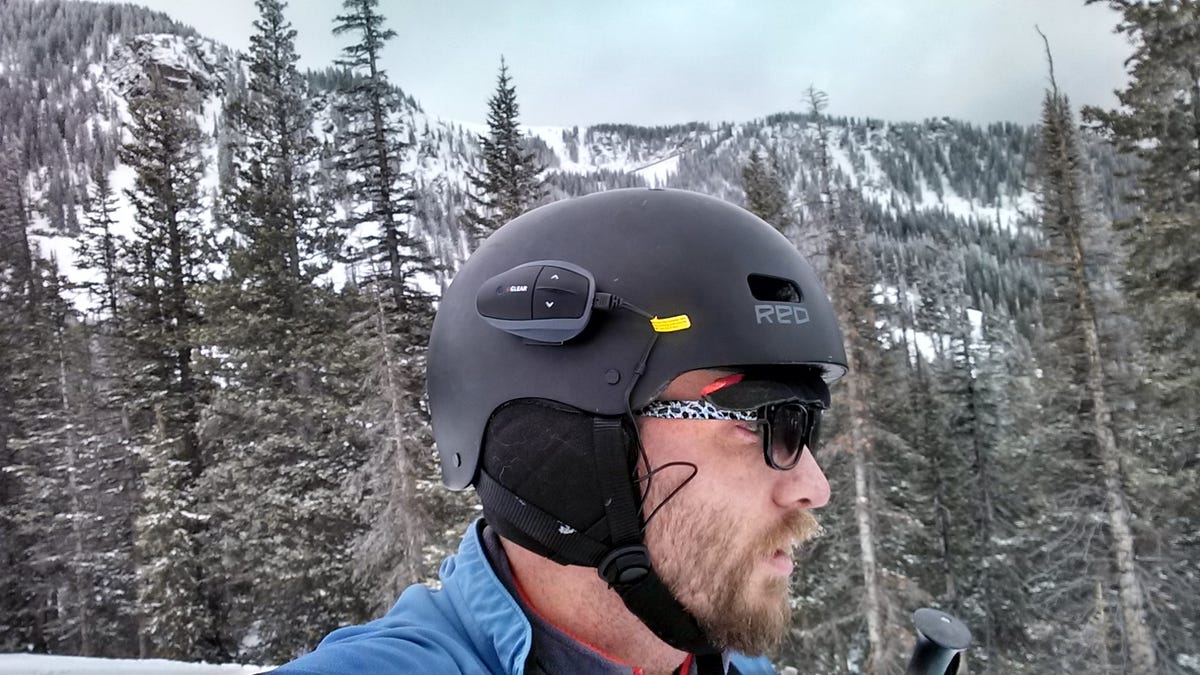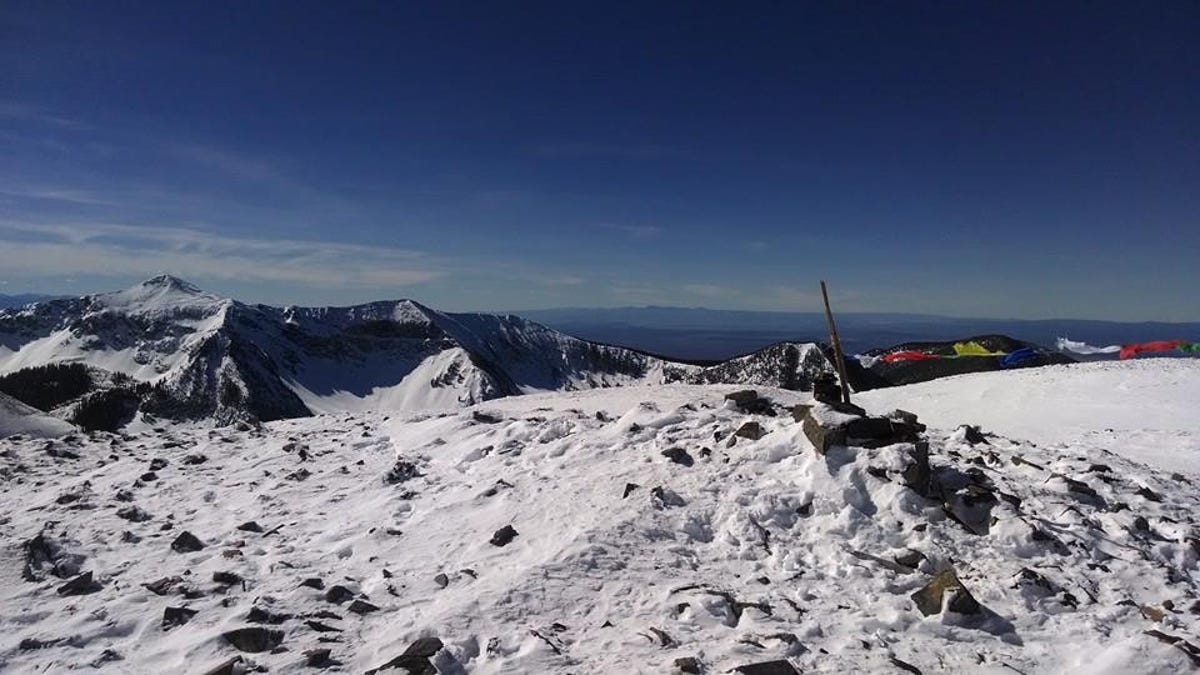
Eric Mack/CNET
TAOS SKI VALLEY, N.M. — The best powder on this mountain takes some effort to find. From the parking lot, you’ll need to take two chairlifts, then pop off your skis or board and hike to the top of a gorgeous ridge with views of the tallest peak in New Mexico to your left and the longest continuously inhabited community in the country at Taos Pueblo to your right. If you’re really up for an adventure, you can follow that ridge to the top of 12,400-foot Kachina Peak. Ski patrol calls it a 45-minute hike, but trust me, if you’ve never done it before, it’ll take you an hour or more.
Once you’ve made it to the top, of course, there’s no better way to celebrate than reconquering that steep pitch by tearing down it. What could be better?
I’ll tell you what.
Taking a call on that picturesque ridge in which you learn that you’ve finally had a solid offer on the house you’ve been trying to sell for months, and then sharing your shouts of joy with your wife on the other end of the line while making the first powder-slicing turn of an epic run back down that mountain. You say your I-love-yous and goodbyes by turn three, she hangs up, and the soundtrack in your helmet automatically switches back to “Even Flow” by Pearl Jam.
Sure, maybe this choice of tune dates you a little bit, but you sure aren’t moving down that peak like an old man. Life is good.
This was the moment I decided I could recommend the gear that made all this mountaintop multitasking possible.
I took that call at the top of the mountain by simply telling the UClear HBC100 Plus system installed in my helmet and connected to the Moto X in my coat pocket via Bluetooth to answer it. It took me a few tries to get this boomless helmet entertainment and communication system to work just right, but once it was all figured out, I was hooked.


Eric Mack/CNET
UClear has made boomless Bluetooth headsets/intercoms like the one on my ski helmet for a variety of activities, from motorcycling and snowmobiling to cycling and skiing, but with the HBC100 Plus, a company representative told me, the idea is to create a unit that’s flexible enough to work for just about any activity that requires a helmet.
The product consists of two basic parts — a thumb-size control module that hooks onto the side of your helmet and connects to a pair of large (about the size of Oreo cookies) speakers that must be installed next to where your ears go in your helmet. Each of these speakers also has an integrated microphone, and this is where UClear’s secret sauce is.
The sound quality of this product far exceeded my expectations, at least when it came to the Bluetooth functions. People I called using my Verizon Moto X connected to the UClear in my helmet always expressed shock when I revealed that I was calling from the middle of a run, or from the windy heights of a chairlift.


UClear
The experience of listening to Spotify, audiobooks, or podcasts while on the mountain was also impressively immersive, and without a lot of the cutting in and out that’s common with more basic Bluetooth headsets.
It did take a few tries to get the system up and working, and the included manual was of little help, as is increasingly the case with consumer products these days. Fortunately, UClear offers a pretty comprehensive FAQ and support through its Web site.
Still, it was frustrating when the adhesive on the helmet mount failed just 45 minutes in to my first day with the HBC100 Plus. Turns out that adhesive really needs several hours to bond with the surface of a helmet at room temperature before being exposed to the extreme cold and wind that’s common at 12,000 feet in winter. It would have been nice for this to have been noted in the installation instructions somewhere.
It also took a while to get a comfortable fit for the earpieces. The company told me that some users often need to carve out a space in the rigid foam inside their powersports helmets, but this was not my problem. My solution was to open up my zippered earpads and place the speakers with built-in mics inside. I had avoided doing this from the start because it meant placing a layer of foam, fabric, and hard plastic between the speaker and my ear, not to mention potentially muffling the microphones.
Remarkably, the microphones still managed great sound quality in calls under all those layers, and my music still sounded fine, although I detected just the faintest echo on spoken word audio, thanks to that hard plastic barrier I had introduced.
Extreme (self-)torture testing
(Dear readers, please don’t try anything described in this section without the help of ski patrol.)
The UClear I’d been loaned to test worked great on the chairlift and schussing down the mountain, but I needed to see how it would fare when things got a little hairy. So, I found a nice short black –diamond run that was sufficiently steep, but with a relatively soft, flat landing at the end. Then, rather than ski it, I attempted to fall down it.
Related Stories
- Torture-testing a tough phone with Rocky Mountain rapids
- Best Bluetooth headsets
- Best high-tech ski gear (pictures)
I went straight down the first part of the run to gather a little speed, then steered myself into some moguls on the side of the run. The key to skiing this kind of terrain is to take it on aggressively, leaning into it and keeping your body facing downhill as much as possible. So, to fall down this kind of terrain, you’ll want to be tentative and lean back, raising your center of gravity so that the bumps end up knocking you on your butt.
So I did this, and when I was knocked back and lost control of my skis, I just kind of flung myself forward into what looked like a soft patch, and my momentum carried me into a roll.
After one rotation, I landed on my back, with my head pointing downhill, my helmet scraping against the packed powder until I came to a full stop. I was fine and the UClear on the side of my helmet was just a little scuffed, and the Pearl Jam track playing in my ears never missed a beat.
Not a perfect 10
The UClear is surprisingly rugged, and its large three-button interface and voice control features allowed me to easily navigate audio, calls, and texts, even with mittens. I particularly loved using it with Google Now, Touchless control, and Motorola Assist on my Moto X. Motorola Assist would interpret the motion of skiing or riding a chairlift as me driving, and would automatically read me my texts without any prompting.
However, the intercom feature left a lot to be desired. Its advertised range of 500 meters varied greatly depending on terrain and conditions. I found that without a direct line of sight, the connection was lost almost immediately. For an activity like skiing, where the terrain differs greatly from run to run, and you’re likely to be separated from your buddies by trees, ridges, and often more than 500 meters of distance, it wasn’t particularly useful. This feature is really designed for communicating while riding in close proximity on a road or trail on motorcycles or snowmobiles.
I also found it hard to operate the intercom consistently, but as with the issues I had installing the UClear this could simply be part of a longer learning curve than many of us are used to in the era of instantly intuitive interfaces.
I did make a point of finding out how the UClear sounds next to the roar of an engine, since that’s how many bikers and snowmobile riders will use it. I put on my helmet in my particularly loud-running Dodge truck, put it in four-wheel drive and drove it up a steep 4WD road at the ski area, revving the engine up to 5,000rpm (read: very loud). The UClear is capabale of deafening volume, and without overmodulating, so my tunes still came through loud and clear.
Of course, ski season is wrapping up now, but there are plenty of other activities in the coming months that could require a helmet. Whatever your chosen ones may be, I recommend equipping that headgear with one of these Bluetooth accessories and rocking out to the limit, at least until a call comes in.



